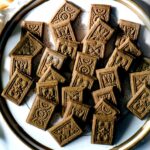
From the Official Downton Abbey Christmas Cookbook.
Gingerbread, which has a long history in much of Europe, first appeared in English cookery books in the late fourteenth century. It was often molded into human shapes-frequently lovers, sometimes even kings and queens-using a wooden mold.
According to ‘The Oxford Companion to Sugar and Sweets’, Elizabeth I commanded her kitchen to shape gingerbread to resemble her courtiers, suitors, and others, which she would then have served to them. By the early nineteenth century, a similar custom was popular at local fairs, where gingerbread “husbands” were bought by girls looking for a sweetheart.
Simpler shapes, such as large squares and freeform biscuits were sold as well, both at fairs and at bakeries. In the Victorian era, gingerbread figures became popular Christmas-tree ornaments.
This recipe from Eliza Acton’s 1845 book, Modern Cookery, was so popular that Florence White included it in Good Things in England, published in 1932. An old-style gingerbread, it calls for black treacle, which yields a pungent result. For a milder flavour, swap out the black treacle for golden syrup or light molasses.
Downton's Gingerbread Biscuits
Ingredients
- 1 3/4 cups flour plus more for the parchment and the mold (if using)
- 1 tbsp. ginger ground
- 1/4 tsp. allspice ground
- 1/4 tsp. mace ground
- 6 tbsp. unsalted butter at room temperature
- 1/4 cup dark brown sugar firmly packed
- 1/2 cup black treacle or molasses
Instructions
- Preheat the oven to 275°F (135°C). Line 2 sheet pans with parchment paper.
- In a large bowl, whisk together the flour, ginger, allspice, and mace. Add the butter and, using your fingers, rub it into the flour mixture until the mixture is the consistency of coarse bread crumbs. Add the sugar and stir with a wooden spoon until fully incorporated. Pour in the treacle and mix until blended. Now knead the dough in the bowl until smooth and evenly dark.
- Lay a sheet of parchment paper on a work surface, dust it lightly with flour, place the dough in the center, and pat it into a thick, flat disk. If using a cookie cutter, roll out the dough a scant ~ inch (6 mm) thick. Using a cutter in any shape you like, cut out as many biscuits as possible. Transfer them to the prepared pans, spacing them about 3/4 inch (2 cm) apart. Gather up the scraps, roll out, cut out more biscuits, and add to the pans.
- If using a wooden gingerbread mold, roll out the dough about 1/3 inch (8 mm) thick or thicker, depending on the depth of the carving. Dip the mold into water and dust lightly with flour. Cut a piece of rolled-out dough about I ~ inches (3 cm) larger than the carving. Lay it on the prepared mold, then roll the rolling pin over the mold, pushing the dough into the carving. Trim any excess dough from the edge of the mold and turn the biscuit out onto a prepared pan. Repeat to make as many biscuits as possible, adding them to the pans and spacing them about I inch (2.5 cm) apart.
- Gather up the scraps, roll out, press out more biscuits, and add to the pans.
- Bake the biscuits, rotating the pans back to front halfway through baking, until crisp, about 30 minutes. Let cool on the pans on wire racks for 5 minutes, then transfer the biscuits to the racks and let cool completely.
